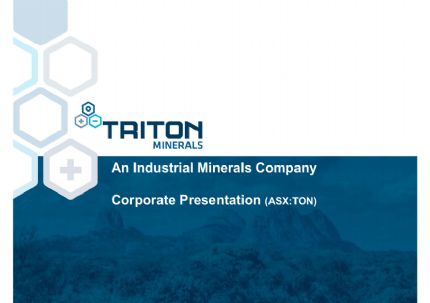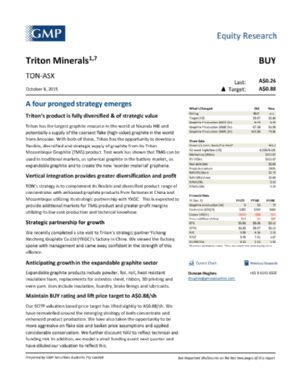
Positive Metallurgical Results For Nicanda Hill
Perth, Sep 16, 2014 AEST (ABN Newswire) - Triton Minerals Limited ( ASX:TON) ("Triton", "the Company") is pleased to confirm receipt of the initial metallurgical and mineralogical results for the Nicanda Hill prospect.
ASX:TON) ("Triton", "the Company") is pleased to confirm receipt of the initial metallurgical and mineralogical results for the Nicanda Hill prospect.
Triton Minerals Managing Director Brad Boyle said "These preliminary metallurgical and mineralogical results are very encouraging for Triton, showing once again that a very high grade graphitic concentrate of up to 97.3% TGC is obtainable from straight forward flotation methods.
A more detailed metallurgical and mineralogical test work program is now being conducted from a wider range of locations from across the mineralisation footprint, to obtained a more accurate and representative sample of the graphitic ore and to obtain a better understanding of the physical characteristics of the graphitic material."
METALLURGICAL RESULTS
The Company confirms the initial metallurgical test work has returned very promising results with the head assay results demonstrating an average graphite grade of up to 19.5% TGC being obtained from the bulk sample of 200kgs. Also of note was the encouraging results in relation to the Vanadium within the graphitic mineralised material obtaining an average grade up to 0.35% for the V2O5.
The bulk sample used in the initial metallurgical and mineralogical test work program was obtained from several locations on drill section N2 on the Nicanda Hill prospect.
The Company is currently focusing on the northern prospects of the footprint in regards to the ongoing drilling and metallurgical test work, due to the identification of strong graphitic mineralisation and flake graphite, in particular within the weathered zones.
Now that Triton has access to the northern prospects of the mineralisation footprint, which is showing a number of positive variations in the physical characteristics of the graphitic ore, further bulks samples are being obtained from the northern area of the footprint for comparison and create more detailed and representative understanding of the graphitic material found across the mineralisation footprint.
Triton also confirms the preliminary flotation test work has confirm that high grade graphitic concentrate of up 97.3% TGC can be readily produced using the straight forward and proven extraction methods of crushing, grinding and flotation.
These initial results are very positive and demonstrates the graphitic material liberates well to obtain high grade graphite concentrate and the early stage flotation test work has also shown graphite concentrate of up 95%, can be obtained at a relatively coarse primary grind of 500µm. Triton believes that these liberation characteristics are a significant development as previously the high grade concentrate from the Cobra Plains deposit was only achievable from a finer grind size.
Triton confirms the graphite flotation test work program is ongoing and is now focused on refining the flotation methods for optimising the overall graphite recovery, final graphite concentrate grades and product size distribution.
The Company verifies that more detailed metallurgical and mineralogical investigations will be completed over the coming months and Triton plans to complete further testing on a larger scale of samples that are representative of the entire mineralisation zone at the Nicanda Hill prospect.
Triton is also pleased to verify that vanadium recovery test work has been initiated on the graphite flotation tailings. Initial analysis of the graphitic material shows that the vanadium is present in a flake form which may lend itself to being beneficiated through the standard flotation methods.
The Company notes that these initial vanadium tests found the high grade vanadium concentrate was being recovered from a full range of vanadium flake sizes. Triton plans to undertake a detailed vanadium test work program focused on testing the flotation and other methods for optimising the overall vanadium recovery from the graphite tailings and the final vanadium concentrate grades.
GRAPHITE FLAKE DISTRIBUTION
Initial mineralogical investigations of the samples obtained from the Nicanda Hill prospect have confirmed the substantial presence of medium and coarse flake graphite of up to 1mm in length on the Nicanda Hill prospect.
Triton confirms mineralogical tests from in situ samples obtained from the mineralisation footprint, verify a range of graphite flake sizes from fines through to jumbo flake.
The Company confirms from these preliminary test results, they show on average the graphite flake size distribution in these samples are as follows; 36.8% of the flakes in the samples are 150µm or larger, 32.2% are greater than 75µm and 31% are less than 75µm in size. These initial results are outlined below in Table 1.
-----------------------------------------Graphite Flake Length Flake Distribution----------------------------------------- +150µm 36.8% +75µm 32.2% -75µm 31.0%-----------------------------------------
Table 1. Mineralogical Flake size distribution of the graphite as obtained from samples at Nicanda Hill.
The Company notes the ratio of graphite flake sizes is unlikely to remain constant and this is just an indicative representation of the sizing, based on the limited samples obtained to date. Triton advises that as a result of the processing during the metallurgical test work phases or during real world processing conditions, it is likely the graphite flake sizes will be changed. However, the additional metallurgical test work is focusing on refining the graphite flotation methods and will be looking for ways to maximise the overall recovery and conservation of the graphite flakes.
Triton also notes that the graphite flotation test work program is ongoing and is looking to refine the graphite flotation and recovery methods, in order to produce the highest quality graphite concentrate. Triton's research with potential end users has found that obtaining a graphite concentrate between 94% and 97% purity is the key requirement for these possible customers, over and above the issue of graphite flake sizing.
Triton finds these preliminary in situ flake size distribution results are very promising and is keen through further test work to obtain a better understanding of the physical characteristics graphitic material throughout the mineralisation footprint in order to identify the most prospective areas for future mining activities taking into account graphite grades and flake sizing.
Triton notes that these very encouraging graphite and vanadium concentrate results and the overall graphite flake size distributions are based on initial limited samples obtained by the Company prior to the identification of the higher grade near-surface graphitic material located in the northern prospects of the mineralisaton footprint. Since then the mineralisation footprint has grown to 6.2km long and more representative metallurgical and mineralogical test work program is warranted in order to determine true physical characteristics of the overall graphitic ore body.
Triton feels an expanded metallurgical and mineralogical work program focused on testing the near-surface oxidised graphitic material could potentially provide the Company with better overall graphitic grades and larger flake recovery.
Based on initial observations, the graphitic material in the northern prospects of the mineralisation footprint appears to host better graphite flake and grade within the weathered zone. Triton feels that if the metallurgical and mineralogical test work confirms these observations then the weathered zone in the northern prospects could possibly become the primary focus for Triton in the first 2-5 years of proposed graphite production.
Finally, these strong vanadium assay results increase Triton's confidence in the Nicanda Hill prospect, as a very large multi-element project and these results also underscore the potential importance of vanadium with respect to the overall future economics of the project when in production.
CONCLUSIONS
These positive initial metallurgical and mineralogical results with high grades obtained in the head assays for both the graphite and vanadium, combined with the identification of medium and large flake graphite is a very encouraging start for Triton.
Further the recovery of the very high grade graphitic concentrates of up to 97.3%, extracted through standard and straight forward flotation methods demonstrates the world class quality of the Nicanda Hill prospect.
The Company remains extremely confident that the Balama North project will host one of largest high-grade graphite and vanadium projects in the world.
About Triton Minerals Ltd
 Triton Minerals Limited (ASX:TON) is an ASX listed, responsible mineral explorer and resource management company headquartered in Perth, Australia.
Triton Minerals Limited (ASX:TON) is an ASX listed, responsible mineral explorer and resource management company headquartered in Perth, Australia.
Led by a highly experienced management team, Triton Minerals' vision is to grow shareholder's value through discovery or development of base metal, gold and other precious metal deposits.
Triton has made excellent progress with its three Graphite projects located in the Cabo Delgado Province in Mozambique, with the program successfully identifying a number of graphitic exposures.
It is the Company's belief that the Mozambique, Balama North Project could host multiple and very substantial world class graphite deposits.
| ||
|






